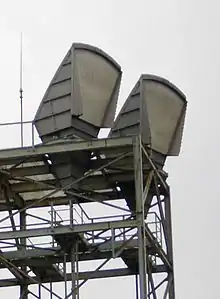Microwave antenna
A microwave antenna is a physical transmission device used to broadcast microwave transmissions between two or more locations.[1] In addition to broadcasting, antennas are also used in radar, radio astronomy and electronic warfare.
%252C_satelity_s_v%C3%BDhledem_do_krajiny.JPG.webp)

Microwave frequency bands
| C band | 4 to 8 GHz | 3.75 cm to 7.5 cm | 4 GHz, 6 GHz |
| X band | 8 to 12 GHz | 25 mm to 37.5 mm | 10 GHz, 11 GHz |
| Ku band | 12 to 18 GHz | 16.7 mm to 25 mm | 12 GHz, 18 GHz |
| K band | 18 to 26.5 GHz | 11.3 mm to 16.7 mm | 18 GHz |
| Ka band | 26.5 to 40 GHz | 5.0 mm to 11.3 mm | 23 GHz, 31 GHz |
| Q band | 33 to 50 GHz | 6.0 mm to 9.0 mm | 38 GHz |
| W band | 75 to 110 GHz | 2.7 mm to 4.0 mm | 70 GHz, 80 GHz, 90 GHz |
Uses
- One-way (e.g. television broadcasting) and two-way telecommunication using communications satellites
- Terrestrial microwave relay links in telecommunications networks including backbone or backhaul carriers in cellular networks linking BTS-BSC and BSC-MSC.
- Radar
- Radio astronomy
- Communications intelligence
- Electronic warfare
Antenna types
Reflector antennas
A parabolic antenna is an antenna that uses a parabolic reflector, a curved surface with the cross-sectional shape of a parabola, to direct the radio waves. These devices range anywhere from 6" to more than 12' diameter depending on application and use.
Horn antennas
A horn antenna or microwave horn is an antenna that consists of a flaring metal waveguide shaped like a horn to direct radio waves in a beam. Horns are widely used as antennas at UHF and microwave frequencies, above 300 MHz.[3]
Lens antennas
A lens antenna uses a lens to direct or collect microwave radiation.
Array antennas
An array antenna is a high gain antenna consisting of an array of smaller antenna elements.
References
- Balanis, Constantine. Antenna theory; analysis and design (3rd ed.).
- "Point-to-Point Microwave". 22 February 2016.
- Bevilaqua, Peter (2009). "Horn antenna - Intro". Antenna-theory.com website. Retrieved 2010-11-11.
